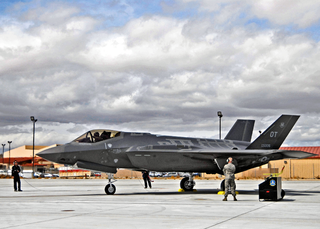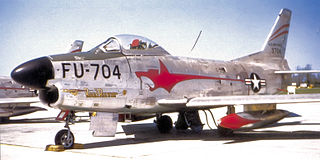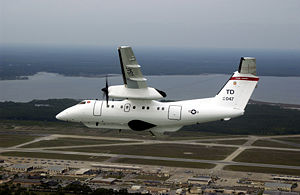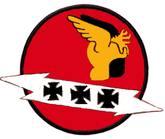
Aerospace Defense Command was a major command of the United States Air Force, responsible for air defense of the continental United States. It was activated in 1968 and disbanded in 1980. Its predecessor, Air Defense Command, was established in 1946, briefly inactivated in 1950, reactivated in 1951, and then redesignated Aerospace rather than Air in 1968. Its mission was to provide air defense of the Continental United States (CONUS). It directly controlled all active measures, and was tasked to coordinate all passive means of air defense.

The 53rd Wing is a wing of the United States Air Force based at Eglin Air Force Base, Florida. The wing reports to the United States Air Force Warfare Center at Nellis Air Force Base, Nevada, which in turn reports to Headquarters Air Combat Command.

The 78th Air Base Wing is a wing of the United States Air Force stationed at Robins Air Force Base, Georgia. The 78th acts as the host unit at Robins.

The 325th Fighter Wing is a wing of the United States Air Force based in Tyndall Air Force Base, Florida.

The 328th Armament Systems Wing is an inactive wing of the United States Air Force (USAF). It was last active in 2007, assigned to the Air Armament Center, part of Air Force Materiel Command (AFMC) at Eglin Air Force Base, Florida. It was first activated in 1942 as the 328th Fighter Group and served during World War II as a fighter aircraft training unit until disbanded in 1944 in a major reorganization of the Army Air Forces.

The 20th Fighter Squadron is an inactive United States Air Force (USAF) squadron. It was most recently part of the 49th Fighter Wing at Holloman Air Force Base, New Mexico, where it operated the McDonnell F-4 Phantom II aircraft, conducting training and air superiority missions. It was inactivated on 20 December 2004.

The 62d Fighter Squadron is part of the United States Air Force 56th Operations Group at Luke Air Force Base, Arizona. It operates the Lockheed Martin F-35A Lightning II aircraft conducting advanced fighter training.

The 95th Fighter Squadron, nicknamed the Boneheads, is an active squadron of the United States Air Force. Last activated on 15 June 2023 as a Lockheed Martin F-35 squadron stationed at Tyndall Air Force Base, Florida. Previously the 95 FS was an F-22 equipped squadron, but in 2019 the squadron's aircraft and personnel were distributed across other bases in the aftermath of Hurricane Michael in 2018 and its destruction of large parts of Tyndall Air Force Base. It was subsequently disbanded in 2019. In August 2023, the unit received its first Lockheed Martin F-35A Lightning II aircraft.

The 96th Flying Training Squadron is part of the 340th Flying Training Group and is the reserve associate to the 47th Flying Training Wing based at Laughlin Air Force Base, Texas. It operates T-1 Jayhawk, T-6 Texan II, and T-38 Talon aircraft conducting flight training.

The 97th Flying Training Squadron is part of the 340th Flying Training Group and is the Reserve associate to the 80th Flying Training Wing based at Sheppard Air Force Base, Texas.

The 83d Fighter Weapons Squadron is a United States Air Force unit, assigned to the 53rd Weapons Evaluation Group and stationed at Tyndall Air Force Base, Florida.

The 29th Test and Evaluation Squadron is an active United States Air Force unit. It is assigned to the 753d Test and Evaluation Group, at Eglin Air Force Base, Florida.

The 53rd Test and Evaluation Group is a group of the United States Air Force. It is a part of the 53rd Wing, and is headquartered at Nellis AFB, Nevada.

The 53rd Weapons Evaluation Group is a United States Air Force unit that reports to the 53rd Wing. It is stationed at Tyndall Air Force Base, Florida. The unit is part of Air Combat Command.

The 82nd Operations Group is an inactive United States Air Force unit. It was last assigned to the 82nd Training Wing, stationed at Williams Air Force Base, Arizona. It was inactivated on 31 March 1993.

The 525th Air Defense Group is a disbanded United States Air Force organization. Its last assignment was with the 4710th Air Defense Wing at New Castle County Airport, Delaware, where it was inactivated on 18 August 1955. The group was originally activated as the 525th Air Service Group, a support unit for a combat group at the end of World War II in Italy and then redeployed to Maine, where it supported redeploying units until it was inactivated in 1945.
The 4703d Defense Wing is a discontinued United States Air Force organization. Its last assignment was with Air Defense Command (ADC)'s Western Air Defense Force at Larson Air Force Base (AFB), Washington. It was established in 1952 in a general reorganization of Air Defense Command (ADC), which replaced wings responsible for a base with wings responsible for a geographical area. It then assumed control of several Fighter Interceptor squadrons that had been assigned to the 101st Fighter-Interceptor Wing, which was an Air National Guard unit mobilized for the Korean War. The wing's 569th Air Base Group briefly assumed the host responsibility for Larson, but the wing and group were inactivated only 45 days later when Larson became a Tactical Air Command base. The wing's units were transferred to the nearby 4702d Defense Wing.

The 325th Operations Group is the flying component of the 325th Fighter Wing, assigned to Air Combat Command of the United States Air Force. The group is stationed at Tyndall Air Force Base, Florida. It conducts training on the Lockheed Martin F-22 Raptor and commands one operational Raptor squadron. It directs the flying and support operations of two F-22 squadrons, a fighter training squadron, an operations support squadron and a training support squadron.

The United States Air Force's 66th Weapons Squadron is a United States Air Force Weapons School Fairchild Republic A-10 Thunderbolt II instructional flying unit, at Nellis Air Force Base, Nevada.

The Air Defense Weapons Center is an inactive unit of the United States Air Force, last stationed at Tyndall Air Force Base, Florida. It was last assigned to First Air Force, Tactical Air Command, and was inactivated on 12 September 1991





























